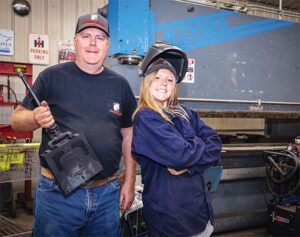
A stamping company that Ryan Steinert, an Enterprise Minnesota business consultant, worked with had a piece of equipment that employees were sure was consistently stamping parts at a rate of one every seven seconds. They used that number to plan projects and bid out jobs. The only problem: It was wrong.
During a demonstration of Guidewheel, a new tool Enterprise Minnesota is offering to help manufacturers improve efficiency, the company discovered that its machine was hiccupping and would stamp at longer intervals erratically. Further investigation showed that some of the problem was the machine and some stemmed from how it was being operated, but whatever the cause, it was hurting profitability.
“Guidewheel can see what you can’t,” Steinert says. “It makes the invisible visible.”

Guidewheel (guidewheel.com) is one of several new hardware and software solutions available to improve efficiency and track performance in real time. According to Guidewheel’s creator, it improves efficiency on average by 16% and reduces operating costs by 11%. While similar internal monitoring functions are built into some equipment, many older machines don’t have it and some firms don’t use it. “We saw it as a big gap that many clients don’t use them,” says Ally Johnston, an Enterprise Minnesota business growth consultant.
Guidewheel measures electrical usage to determine how well and fast machines are running. It can measure downtime, long changeovers and late starts, power surges, and other problems in equipment. Companies use the tool to monitor equipment that may be in need of maintenance or to assess the return on investment of replacing equipment. Enterprise Minnesota has used it in Kaizen events as well as to highlight areas for improvement or diagnose issues, Johnston says.
How it works
The Guidewheel tool starts with a sensor that is clipped onto the power supply of any machine. It can be hooked to anything that draws electricity. After the sensor is calibrated, which takes about four hours, it monitors for power usage, measuring spikes, downtime, and blips that can be translated into metrics used for decision making. An artificial-intelligence powered dashboard allows employees to see data remotely, and it alerts operators when a problem is occurring. The dashboard can be accessed from a cell phone, which is particularly helpful to fully automated companies or those running lights out. If a problem occurs, Guidewheel alerts the appropriate employee.
“Wherever you are in the world, you can see the machine,” Johnston says.
“I’ve had clients surprised by the spikes in energy consumption,” she says, which has led to adjustments such as doing high-usage activities at different times of the day or adjusting work schedules or processes to use the equipment more efficiently. “A lot of times people know something is happening with their equipment, but this gives them the data they need to take the next step.”

“Guidewheel works really well for bottleneck areas,” says Eric Blaha, an Enterprise Minnesota business growth consultant. One company found that its equipment was often operating at 30 or 40% of its potential, but it had spikes where it was operating at 80 or 90%. Using that information, the company found that a lot of time was spent setting up the machine. “It was really eye-opening for them,” he says.
Another firm discovered that a key piece of equipment was operating only 25% of the time. “When we dug into the reasons why, it was due to a lack of consistency in material delivery,” Blaha says. “We designed a Kaizen event to optimize material flow, allowing us to address the root cause of low utilization and improve overall productivity.”
How efficient should your equipment be? There are no clear rules for that, Blaha says. “In some industries, if you get north of 60% utilization, you’re doing well,” he says. “If your utilization is under 50%, it’s a good idea to look at what’s happening.”
Common problems include unplanned maintenance on equipment, worker shortages, or slow setup times. “If equipment is down because of people issues, you can address that,” he says. In other cases, Guidewheel can uncover machine-based problems. Blaha worked with a company whose machine was issuing nuisance fault codes. “We installed Guidewheel on the equipment and were able to identify a spike in amp draw that occurred immediately before the fault code and downtime was logged,” he says. The company determined that machine overload was causing the problem and identified several possible sources. Workers are addressing each of the possible causes separately to resolve the issue.
Enterprise Minnesota has two Guidewheel units available for continuous improvement projects.
Return to the Winter 2024 issue of Enterprise Minnesota® magazine.


